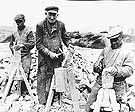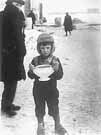
|
|
|

|

|

|

|
|
Click on an image to see a larger, more detailed picture.
|
|
|
|
|
| 1941: Mass Murder |

|
pg. 273 |

|
|
|
|
| |
 Wilhelm Kube was a Nazi official who was appointed Generalkommissar of Belorussia in 1941. One of the earliest members of the Nazi Party, Kube was a Nazi deputy in the Weimar Republic's Reichstag before Hitler's ascension to power in 1933. A political figure to the end, Kube opposed SS deportations and mass murder because he didn't want more Jews brought into his area. He was assassinated by a Russian partisan disguised as a housemaid in September 1943.
Wilhelm Kube was a Nazi official who was appointed Generalkommissar of Belorussia in 1941. One of the earliest members of the Nazi Party, Kube was a Nazi deputy in the Weimar Republic's Reichstag before Hitler's ascension to power in 1933. A political figure to the end, Kube opposed SS deportations and mass murder because he didn't want more Jews brought into his area. He was assassinated by a Russian partisan disguised as a housemaid in September 1943.
Photo: Berlin Document Center / United States Holocaust Memorial Museum Photo Archive
|
 These Jews, confined to a German work camp in Occupied Russia, chisel the mortar off the bricks of destroyed buildings. As the Germans made their way through the Soviet Union, they wrought such havoc that many structures had to be rebuilt from scratch, often making use of the materials left in the Wehrmacht's wake.
These Jews, confined to a German work camp in Occupied Russia, chisel the mortar off the bricks of destroyed buildings. As the Germans made their way through the Soviet Union, they wrought such havoc that many structures had to be rebuilt from scratch, often making use of the materials left in the Wehrmacht's wake.
Photo: SYddeutscher Verlag Bilderdienst
|
 Kovno Ghetto
Kovno Ghetto
Of the 30,000 Jews who made up the original population of the Kovno (Lithuania) Ghetto, more than 90 percent did not survive to liberation. During the first six weeks of the German occupation in 1941, Lithuanian extremists arrested thousands of Jews, imprisoning them in several old forts that ringed the city. Almost 4000 Jews perished. Many women were raped, then shot. The dead were thrown into pits. Systematic Einsatzgruppen murders began once ghetto gates closed in August. In September some 1600 men, women, and children were shot. On October 4 about 1800 were murdered, including 180 children and infant patients who were burned alive when the Germans set fire to the ghetto hospital. The "Great Action" of October 28 separated Kovno Jews "fit" to work from those "unfit." About 9200 were sent "to the right," to be killed. The remaining 17,000 toiled as slave laborers. In late 1943 the Nazis began to liquidate the ghetto, deporting many to concentration camps. In March 1944 the SS dragged all children under the age of 12 from homes and hiding paces. This so-called "Children's Action" claimed 1300 lives. A mother's diary recorded the horror of watching her child "tossed like a puppy into the truck...."
Photo: George Kadish/United States Holocaust Memorial Museum Photo Archive
|
|

|

|

|

|
 October 14, 1941: German Jews are deported to the Lódz (Poland) Ghetto.
October 14, 1941: German Jews are deported to the Lódz (Poland) Ghetto.
|
 October 15, 1941: German authorities in Poland decree that any Jew found outside a designated ghetto will be shot. Further, any non-Jewish Pole who aids a Jew will be executed.
October 15, 1941: German authorities in Poland decree that any Jew found outside a designated ghetto will be shot. Further, any non-Jewish Pole who aids a Jew will be executed.
|
 October 16, 1941: German and Romanian forces occupy Odessa, Ukraine.
October 16, 1941: German and Romanian forces occupy Odessa, Ukraine.
|
 October 16, 1941: Three days after the German murder of 15,000 Jewish residents of Dnepropetrtovsk, Ukraine, an additional 5000 Jews are executed in the town.
October 16, 1941: Three days after the German murder of 15,000 Jewish residents of Dnepropetrtovsk, Ukraine, an additional 5000 Jews are executed in the town.
|
 October 16, 1941: The first SS deportation train of Western Jews travels to ghettos at Lódz, Lublin, and Warsaw, Poland.
October 16, 1941: The first SS deportation train of Western Jews travels to ghettos at Lódz, Lublin, and Warsaw, Poland.
|
 October 16-November 4, 1941: Twenty trains carrying nearly 20,000 Jews travel from Germany, Luxembourg, Czechoslovakia, and Austria to the Lódz (Poland) Ghetto.
October 16-November 4, 1941: Twenty trains carrying nearly 20,000 Jews travel from Germany, Luxembourg, Czechoslovakia, and Austria to the Lódz (Poland) Ghetto.
|
 October 18-20, 1941: Mass executions of Soviet Jews in Borisov, Belorussia, 50 miles east of Minsk, Belorussia, are carried out by an Einsatzkommando following a night of celebration by German troops.
October 18-20, 1941: Mass executions of Soviet Jews in Borisov, Belorussia, 50 miles east of Minsk, Belorussia, are carried out by an Einsatzkommando following a night of celebration by German troops.
|
|
|
|
|
| 1941: Mass Murder |

|
pg. 273 |

|
|
The Holocaust Chronicle
© 2009 Publications International, Ltd.
|
|
